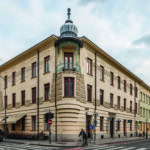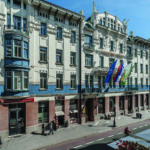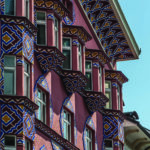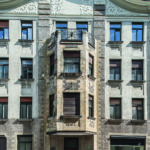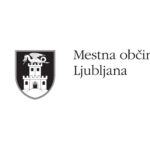Ljubljana was the capital of the Austro Hungarian Province of Carniola at the end of the 19th century having less than 30000 inhabitants and being very rural in appearance. The turning point was the devastating earthquake which struck the town in 1895. Immediately after that the regulation plan was prepared with the help of two top experts in urban planning of the time in Vienna, Camillo Sitte and Maks Fabiani. The image of Ljubljana started to change rapidly and the first echoes of the new Secessionist style in Ljubljana appeared.
Secessionist Ljubljana”, which developed mainly in the first decade of the 20th century is the synonim for the whole town quarter between the old medieval core and the railway line. The first real secessionist work, Dragon Bridge (Zmajski most) by the Dalmation architect Jurij Zaninovic was erected only in 1901.
The architecture of Ljubljana was mainly influenced by Vienna Secession and its special variant of modern art, accentuating more rational and geometric forms. Maks Fabiani and Joze Plecnik, two central figures of modern Slovene architecture are internationally recognized as co-founders of modern art movement in Vienna.
While Plecnik contributed to the Secessionist movement only in his early works in Vienna, Fabiani gave an important character of the period to Ljubljana. His architecture shows the evolution from the decorative Secessionist to the modernist phase, in which he concentrated on trying to use and re-create the traditional local elements in a modern way.
Although Secession mainly left its imprint on the decoration of the facades, in some cases, modernism surpassed the use of individual stylistic elements and intervened also in the building structure.
Even more than architecture Art Nouveau influenced the style of furnishing domestic and public interiors. Several important factories in Slovenia produced decorative and functional objects for everyday use. The ideals of Art Nouveau inspired painting as well, particularly the caricature, illustration and different kinds of graphic arts. The most important was the group of young painters Vesna, who studied in Vienna at the turn of the century, absorbing the decorative language of Vienna Secession and introducing the Slovene folk art motifs into their art.
| Image | artist | function | date |
|---|---|---|---|
| Maks Fabiani | architect | 1865-1962 | |
| Joze Plecnik | architect | 1872-1957 | |
| Ciril Metod Koch | architect | 1876-1925 | |
| Josip Vancas | architect | 1859-1932 | |
| Friedrich Sigmundt | architect | 1856-1917 | |
| Jurij Zaninovic | architect | 1876-1946 | |
| Ivan Vurnik | architect | 1883-1980 | |
| Maksim Gaspari | painter | 1883-1980 | |
| Sasa Santel | painter | 1883-1945 | |
| Hinko Smrekar | painter | 1883-1942 | |
| Fran Berneker | sculptor | 1874-1932 |
| Cover | Author | Description | date | Link |
|---|---|---|---|---|
| Simonišek, R. | Slovenska secesija Ljubljana, Slovenska matica |
2011 | ||
| Hrausky, A., Koželj, J. | Maks Fabiani: Dunaj, Ljubljana, Trst. Ljubljana, Cankarjeva založba |
2010 | ||
| Obal, F. | Obal, F. Murska Sobota, Pomurska založba Ljubljana, Znanstveni inštitut Filozofske fakultete |
2002 | ||
| Žmuc, I. | Homo sum --- Ivan Hribar and his Ljubljana Ljubljana, Mestni muzej |
1998 | ||
| Pirkovič, J., Mihelič, B. | Art nouveau Architecture in Slovenia Ljubljana, Ministrstvo za kulturo, Uprava Republike Slovenije za kulturno dediščino |
1998 | ||
| Pozzetto, M. | Maks Fabiani - vizije prostora Kranj, L.I.B.R.A. |
1997 | ||
| Burkhardt, F. (ur.), Eveno, C. (ur.), Podrecca, B. (ur.) | Jože Plečnik: Architekt 1872-1957 1986, 1987? München, Callwey |
|||
| Dežman, J. (ur.), Hudales, J. (ur.), Jezernik, B. (ur.) | Slovensko meščanstvo: od vzpona nacije do nacionalizacije (1848-1948) Celovec, Mohorjeva |
2008 | ||
| Koželj, J. (ur.), Repše, R. (ur.) | Ivan Vurnik: 1884-1971: slovenski arhitekt / Slovenian architect Ljubljana, Organizacijski odbor projekta Vurnik |
1994 | ||
| Čopič, Š., Prelovšek, D., Žitko, S. | Ljubljansko kiparstvo na prostem. Ljubljana, DZS |
1991 | ||
| Prelovšek, D. | Slovene Insurance Company building Ljubljana, Zavarovalna skupnost Triglav |
1988 | ||
| Fabiani, M. | O kulturi mesta: spisi 1895-1960 Trst, Založništvo Tržaškega tiska |
1988 | ||
| Pozzetto, M. | Max Fabiani: ein Architekt der Monarchie Wien, Edition Tusch |
1983 | ||
| Prelovšek, D | Josef Plečnik: Wiener Arbeiten von 1896 bis 1914 Wien, Tusch |
1979 | ||
| Šumi, N. | Arhitektura secesijske dobe v Ljubljani. Ljubljana, Mestni muzej |
1954 | ||
| Mavrični svet Schützove keramike katalog Celje, Pokrajinski muzej Celje |
2009 | |||
| Kos, M., Lozar Štamcar, M., Pajagič Bregar, G. | Secesija po slovensko Ljubljana, Narodni muzej |
1997 | ||
| Žmuc, I., Rebolj, J. | Homo sum Ljubljana, Mestni muzej. |
1997 | ||
| Prelovšek, D. | Antoni Gaudí in Jože Plečnik: vzporednice / Antoni Gaudí i Jože Plečnik: paral.lelismes / Antoni Gaudí and Jože Plečnik: parallels katalog razstave Ljubljana, Arhitekturni muzej |
1992 | ||
| Kos, M. (ur.), Žargi, M. (ur.) | Gradovi minevajo, fabrike nastajajo: industrijsko oblikovanje v 19. stoletju na Slovenskem Ljubljana, Narodni muzej |
1991 | ||
| Pozzeto, M. (ur.) | Max Fabiani: nuove frontiere dell’ architettura Venezia, Cataloghi Marsilio |
1988 | ||
| Gostiša, J. (ur.), Prelovšek, D. | Arhitekt Jože Plečnik: 1872-1957 razstava v Ljubljani 1986 Ljubljana, Delavska enotnost |
1986 | ||
| Bučić, V. (ur.), Horvat, J. (ur.) | Secesija na Slovenskem: uporabna umetnost, umetna obrt in njej sorodni pojavi v obrtni in industrijski proizvodnji: katalog razstave Ljubljana, Narodni muzej |
1984 | ||
| Pozzetto, M. | La scuola di Wagner 1894-1912: idee - premi –concorsi. Trieste, Comune |
1981 | ||
| Pozetto, M., Cevc, A., Rozman, K., Mušič, M. | Maks Fabiani: 1865-1962 katalog razstave Ljubljana, Narodna galerija |
1977 |
Partner:
City of Ljubljana, Department of Urban Planning
Poljanska 28, 1000 Ljubljana
Slovenia
Phone: +386 (0)1 306 1500
Fax: +386 (0)1 3061557
E-mail: karel.pollak@ljubljana.si; urbanizem@ljubljana.si
Website: www.ljubljana.si/en
Local Partners:
ART NOUVEAU LJUBLJANA:
City Museum of Ljubljana – MGML
National Museum of Slovenia – NMS
National Gallery of Slovenia – NGS
Museum of Architecture and Design – MAO
Department of Art History, Faculty of Arts, University of Ljubljana – FF UL
Urban Planning Institute of the Republic of Slovenia – UIRS
Institute for the Protection of Cultural Heritage, Ljubljana Regional Office – ZVKDS
Links
In the passage of the Urban Planning Institute of the Republic of Slovenia, from 11.06. until 30.08. 2019 exhibition photographic exhibition Secession motifs on Ljubljana houses; renovated secessionist heritage with the co-financing of the City of Ljubljana under the program Ljubljana – My City (LMM) Photographer: Блаж Зупанчич Curator of the exhibition: Polona Zupančič The exhibition… Read more »






